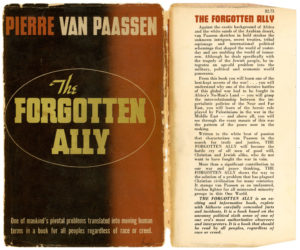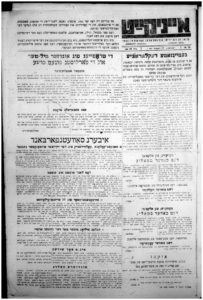While the previous post – about Aufbau’s coverage of Jewish WW II military service – focused on general aspects of the creation of an autonomous Jewish fighting force – “this” post moves to the particular: Aufbau’s reporting on the contribution of the Jews of the Yishuv to the Allied war effort.
The primary topic covered by Aufbau in this context was the contribution of Yishuv Jewry to Britain’s armed forces, in the effort to halt the advance of the Afrika Korps, with the majority of articles of this nature having been published prior to England’s victory in the second battle of El Alamein, during late October – early November of 1942.
Later articles are varied in their subject matter, with some pertaining to the participation of Jewish soldiers in religious services.
| Date | Title |
| 9/39 | IZL – The Jewish National Army |
| 10/39 | Palestine’s Jewish Army – 50,000 Men Could be Put Under Arms |
| 2/40 | Most Destructive Units – Sidney S. Schiff uber die “Legion of Judea” (“Most Destructive Units – Sidney S. Shiff on the “Legion of Judea””) |
| 4/40 | Training in Palästina (“Training in Palestine”) (Photo) |
| 5/40 | Fur Palästina und England! (“For Palestine and England!”) (Photo) |
| 1240 | Jüdische Scharfschutzen werden in Palästina ausgebildet (“Jewish Snipers are Trained in Palestine”) (Photo) |
| 1/41 | Neue Rekrutierungen in Palästina (“New Recruits in Palestine”) |
| 2/41 | Cavalry in Palestine |
| 5/41 | Jüdisches Volk in Waffen – 135,000 Frauen und Manner zur Verteldigung Palästinas bereit (“Jewish people in arms – 135,000 women and men ready for the defense of Palestine”) |
| 5/41 | Neue Truppen nach Palästina (“New Troops to Palestine”) |
| 7/41 | Zum kampf fur Unabhangigkeit und Freiheit – Jüdische Soldaten der palästinenischen Armee auf einem Uebungsmarsch (“The fight for independence and freedom – Jewish soldiers of the Palestinian army on a training march”) (Photo) |
| 8/41 | Palästinas Jüden in Waffen (“Palestine’s Jews at Arms”) (Photo) |
| 10/41 | 2 Palästina-Kongingent in Formierung (“2 Palestine Contingents in Formation”) |
| 12/41 | Helden in Libyien – Palästinensische Truppen in entscheidenden Gefechten (“Heroes in Libya – Palestinian troops in decisive battles”) |
| 12/41 | Judische Soldaten marschieren – Wahrend der in Palastina Mitte Oktober abgehaltenen Rekrutierungswoche haben judische Soldaten im Atadion von Tel-Aviv eine Parade abgehalten (“Jewish soldiers march – During the recruitment week held in Palestine in mid-October, Jewish soldiers held a parade in Tel Aviv Atadion”) (Photo) |
| 6/42 | Aufbruch zur Front: Taglich rucken neue jüdische Einheiten ins Feld (“Departure to the front: New Jewish units move into the field daily”) (Photo) |
| 6/42 | Unter der weiss-blauen Fahne auf der Wacht an der palästinenischen Kuste (“Under the white-blue flag on guard on the Palestinian coast”) (Photo) |
| 8/42 | Die WAACS in Erez Israel heissen PATS ((“The WAACS [Women’s Auxiliary Army Corps] in the Land of Israel are called PATS [Palestine Auxiliary Territorial Service]”) (Photo) |
| 8/42 | Palastinas erstes Regiment (“Palestine’s First Regiment”) |
| 8/42 | In Schatten des Migdal David – Jüdische Soldaten des palästinenischen Buffs-Regiment trainieren zum Kampf gegen Rommel. Von 584,000 Juden in Palästina dienen 47,000 Männer und Frauen in der Landesverteidigung (“In Shadow of the Tower of David – Jewish soldiers of the Palestinian Buffs Regiment train to fight Rommel. Of 584,000 Jews in Palestine, 47,000 men and women serve in the national defense”) (Photo) |
| 9/42 | Jüdisch-palästinensische Soldaten in New York (“Jewish Palestinian Soldiers in New York”) [Bonah, Lighter, Buttermilk, Black] (Photo) |
| 11/42 | Jüdische Freiwillige vom Buff-Regiment im Angriff (“Jewish volunteers from the Buff Regiment on the attack”) (Photo) |
| 11/42 | Palästinensische Schützen: Blaue Bohnen für Rommel (“Palestinian shooters: Blue beans for Rommel”) (Photo) |
| 11/42 | Das Palästina-Regiment wird ausgerustet (“The Palestine Regiment is being organized”) |
| 1/43 | Die jüdische Frau marschiert – Mitglieder der PATS bei einer Demonstration durch die Strassen Tel Avivs (“The Jewish woman march – Members of the PATS in a demonstration through the streets of Tel Aviv”) (Photo) |
| 9/43 | Palästinensische Matrosen, die als Freiwillige in der englischen Navy dienen, tanzen in ihrer Freizeit eine Horrah (“Palestinian sailors serving as volunteers in the English Navy dance a hora in their free time”) (Photo) |
| 9/43 | Jewish Girls as Ambulance Drivers |
| 12/43 | Die jüdische Frau kampft mit – In einer Minenfabrik in Palästina helfen bei der Herstellung und Fullung von Landminen (“The Jewish woman is fighting – In a mine factory in Palestine help in the manufacture and filling of land mines”) (Photo) |
| 1/44 | Palästina Bataillone nach Europa (“Palestinian Battalions to Europe”) |
| 1/44 | Jüdische WAAF in Palästina – Ein Mitglied der WAAF mit der hebraischen Achselklappe “Erez Israel” (“Jewish WAAF in Palestine – A member of the WAAF with the Hebrew epaulet “Erez Israel”) [Photo: British Combine] (Photo) |
| 6/44 | May We Present – Mrs. Jenny Blumenfeld – Who Tells of Palestine’s Women at War |
| 9/44 | Palästina-Truppen in England (“Palestine Troops in England”) |
| 3/45 | Drei Freunde in Palästina (“Three friends in Palestine”) [Heart, Popper, Salm] (Photo) |
Beyond these articles, there is much published literature on the subject of the contribution of the Yishuv – in terms of military manpower, production of war material, scientific research, and economic and support – to the Allied war effort.
A notable wartime publication in this regard is Pierre van Paassen’s 1943 The Forgotten Ally (published by the Dial Press in 1943). One particular chapter of this book – “The Best-Kept Secret of the War” – covers this topic in an illuminating and (even in 2017…) and surprisingly relevant fashion.
The chapters of van Paassen’s book are:
Author’s Preface (5-6)
Chapter I – There Are No More Prophets! (9-48)
Chapter II – Prelude to Palestine’s Liberation (49-104)
Chapter III – Britain’s Role in Palestine (105-174)
Chapter IV – The Best-Kept Secret of the War (175-236)
Chapter V – Imperialism’s Reward (237-303)
Chapter VI – The Solution (304-343)
____________________
The image below shows the front cover of the 1943 (first) edition of The Forgotten Ally…
…and, here is the back cover, with van Paassen’s portrait.
Another book, Israel Cohen’s short but substantive 1942 Britain’s Nameless Ally (published by W.H. Allen & Co., Ltd., Publishers, of London) presents information about the contribution of Yishuv Jewry to the Allied war effort in a more detailed and stylistically different fashion than van Paassen. Statistics about the numbers of Yishuv volunteers serving in the Allied military (particularly Britain’s military) are interspersed and accompanied by quotations of and comments by notable figures in Allied military, political, and news circles. By definition – by – timing (this book was released in 1942, after all) coverage of Jewish military service (in Chapter III, “At The Battle-Fronts”) is limited to military activity in the Western Desert, at Tobruk, in Eritrea, at Keren, in Greece, in Syria, and also in the Auxiliary Territorial Service, while attention is also accorded to Jewish military service in the Czech armed forces.
As a nice touch, the book includes 10 photographs showing military and industrial activity in the wartime Yishuv, and, a frontpiece image of Haifa.
The book’s chapters are:
Chapter I – The Jewish People’s Offer (1-9)
Chapter II – The Rallying of Jewish Volunteers (10-17)
Chapter III – At the Battle-Fronts (18-28)
Chapter IV – The Economic Contributions (29-34)
Chapter V – Scientific and Technical Contributions (35-37)
Chapter VI – The Government and the Jewish Offer (38-46)
Appeal by the Jewish Agency Executive (47)
____________________
A beautiful view of Haifa, the leading image in Britain’s Nameless Ally.
Jewish Settlement Police, and Jewish military personnel (in training).
Of the ten photographs in Britain’s Nameless Ally, six pertain to manufacturing activity in a wartime context. The two illustrations below are representative of these images.
In contemporary terms, Yoav Gelber’s Jewish Palestinian Volunteering in the British Army During the Second World War (published by Yad Itzhak Ben-Zvi Publications, Jerusalem) is an essential – probably “the” essential – work on this topic. The work is comprised of four volumes, one of which (Jewish Volunteers in British Units) has been of tremendous help in my posts concerning female ATS volunteers, and, soldiers of the 462nd General Transport Company lost in the sinking of the HMS Erinpura. Unfortunately (!) the volumes have not yet been translated into English…
The volumes are:
Volume I – Volunteering and its Role in Zionist Policy 1939-1942, 1979
Volume II – The Struggle for a Jewish Army, 1981
Volume III – The Standard Bearers, 1983
Volume IV – Jewish Volunteers in British Units, 1984
____________________
Another relevant publication (just discovered on worldcat.org, but not yet read!) is Anat Granit-Hacohen’s Hebrew Women Join the Forces: Jewish Women From Palestine in the British Forces During the Second World War. Translated by Ora Cummings, the book was published by Vallentine Mitchell in 2017.
The above sources are in German, English, and Hebrew. But, there is another publication which covered Jewish WW II military service, albeit in Yiddish: That is Eynikayt, the official newspaper of the Soviet Union’s Jewish Anti-Fascist Committee.
In its twentieth issue, published on December 17, 1942, the paper included two photographs relating to military service of Yishuv Jewry. One picture shows Jewish soldiers in the British army during training near Libya. The other shows a group of women soldiers under inspection by their sergeant. This latter image is remarkable in presenting the full names of these female soldiers, along with their places of birth or national origin. Unfortunately – ! – neither the photographer nor the official source are listed for either image.
____________________
Eynikayt, December 17, 1942: Page 1.
Eynikayt, December 17, 1942: Page 4.
 “Jewish youths in the British army, not far from Libya, perfect their military skills in order to be deployed soon against the Fascists.”
“Jewish youths in the British army, not far from Libya, perfect their military skills in order to be deployed soon against the Fascists.”
____________________
 “Jewish girls in a British regiment in Palestine (right to left): Ida Hecht (from Czechoslovakia), Khave Friedman (from Germany), Margarita Kahan (from Poland), Regina Altkorn (from Belgium), Yulia Abramson (from Carpathian Ruthenia) and Shoshana Shulman (from Palestine)”
“Jewish girls in a British regiment in Palestine (right to left): Ida Hecht (from Czechoslovakia), Khave Friedman (from Germany), Margarita Kahan (from Poland), Regina Altkorn (from Belgium), Yulia Abramson (from Carpathian Ruthenia) and Shoshana Shulman (from Palestine)”
____________________
Future posts will cover other aspects of Aufbau’s reporting on Jewish WW II military service.







